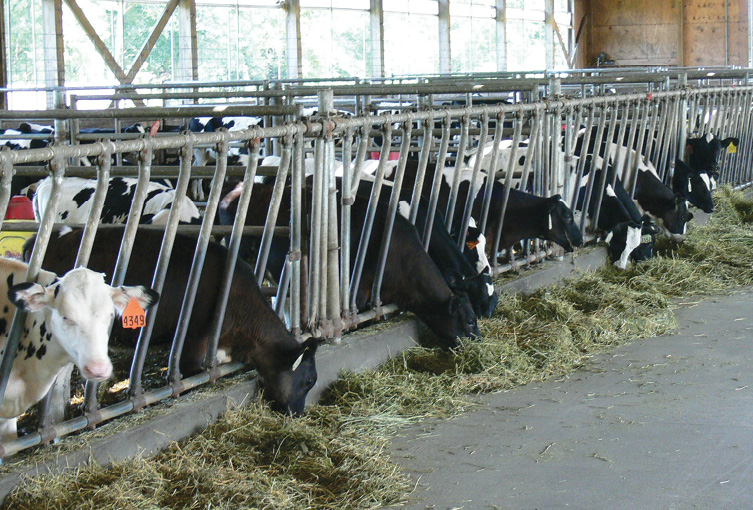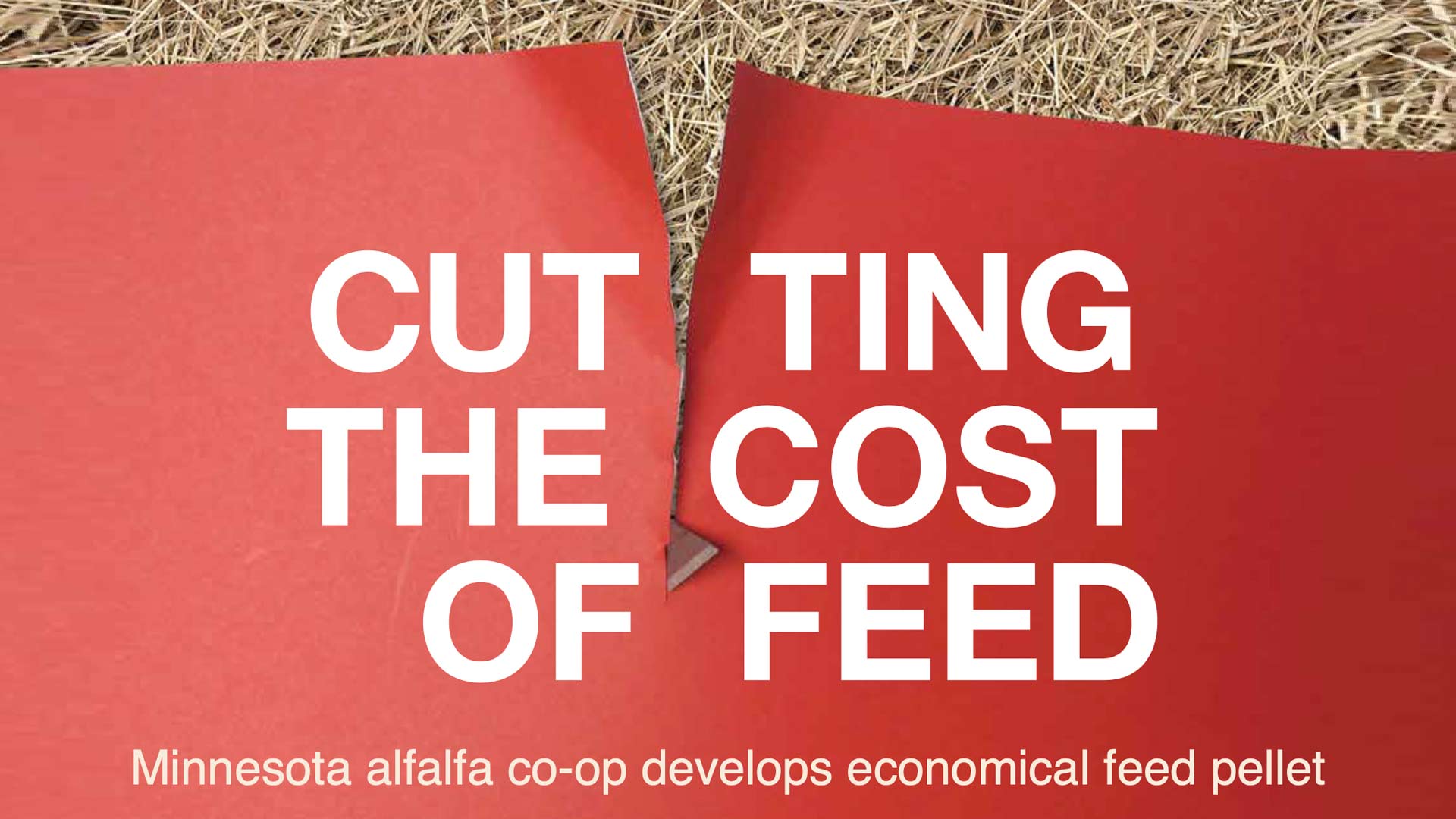–by Liz Morrison
 Soaring hay prices sparked innovation at a Raymond, Minn., feed company.
Soaring hay prices sparked innovation at a Raymond, Minn., feed company.
Short supplies of alfalfa and skyrocketing prices forced Minnesota Valley Alfalfa Producers (MnVAP) to cut production of alfalfa feed pellets by more than 40 percent in 2013. But the co-op rebounded by developing a more economical and nutritious substitute for alfalfa pellets.
“We saw a need and an opportunity,” says Zayna Eischens, MnVAP chief operations officer.
Now, MnVAP is manufacturing a new, mixed-fiber feed pellet that’s higher in energy and lower in cost than alfalfa pellets. In University of Minnesota feeding trials on dairy calves, the blended-fiber pellets outperformed both alfalfa pellets and a standard diet.
“We were trying to create a better pellet at a lower cost,” says longtime alfalfa producer Donn Larson of Madison, Minn., a member of the MnVAP board of directors, “and we succeeded.” The new product will boost MnVAP’s volume of pellets marketed by about 25% this year.
“The results of the feeding trial were very positive,” says Becky Philipp of AURI, “providing solid data to support the pellet as an effective feed alternative. MnVAP has a great new product, which will strengthen their economic vitality. And their customers have a lower-cost feed option.”
Caught in a price squeeze
Over the past two years, alfalfa prices have more than doubled, topping $300 per ton. Values have been pushed up by increased demand from Texas and other livestock regions in the Southern Plains, where pastureland has been ravaged by drought. Meanwhile, competition for cropland from high-priced corn pushed down alfalfa production. “With $7 corn,” Larson says, “a lot of acres of alfalfa were plowed up.”
As the cost of alfalfa became prohibitive for livestock growers, MnVAP’s production dropped from 38,000 tons of alfalfa pellets a year to 21,000 tons in 2013, Eischens says. “We needed to find a feed product that was more economical for our customers,” Larson says. MnVAP’s customers include large cattle feedlots and cow-calf operations throughout the U.S., as well as dairy, lamb, hog, and fish producers.
AURI helps
The manufacturer turned to AURI for help devising a replacement pellet. AURI had helped the 141-member cooperative get organized in 1994 and has worked with the company on other projects since.
MnVAP’s customers wanted an alternative feed pellet that provided the same 17% crude protein as the company’s alfalfa pellet, says Al Doering, AURI’s senior associate scientist for coproducts. “We worked with MnVAP to develop a blend of ag fibers that was equivalent to the nutritional value of alfalfa pellets.”
“We actually made a better pellet as far as energy is concerned,” says Larson. The blended-fiber product contains nearly 5% fat, compared to 1.5% fat in the alfalfa pellets. Fiber content of the blended pellet is about 25% lower than the alfalfa pellet.
Doering tested different pellet formulations for bulk density and durability, qualities that are important for easy handling and shipping. He also helped with manufacturing set-up at the plant.
“AURI was a big help with this,” Larson says.
Performance testing
“We also wanted feedback on actual performance before we started selling the product,” Eischens says. A USDA Rural Cooperative Development Grant helped pay for feeding trials last summer at the University of Minnesota Southern Research and Outreach Center (SROC) in Waseca, Minn.
The 56-day study, led by U of M animal scientist Hugh Chester-Jones, compared three diets for dairy calves:
- standard grower heifer diet of grain plus hay;
- grain plus alfalfa pellets as a partial replacement for hay;
- grain plus blended-fiber pellets as a partial replacement for hay.
Variables measured in the study included feed intake, daily weight gain and feed efficiency. “This was a short study to give us an idea of acceptance and performance,” says SROC scientist David Ziegler, who managed the trials.
The study results have not been published. However, partially replacing hay in a grower diet with alfalfa or blended pellets enhanced heifer performance compared to those fed a standard grower diet, says Chester-Jones. “Heifers fed the blended pellet diet performed better than those fed the alfalfa pellet diet. Some of these difference may be related to the higher energy, lower fiber levels and greater acceptance by heifers fed the blended vs. alfalfa pellet diets.”
The calves “liked the blended pellet best,” Ziegler adds, perhaps because of the higher fat content.
The blended-fiber pellets tended to have a few more fines than the alfalfa pellets, Ziegler says. But that probably wouldn’t be a problem for feedlot operators who include the pellets as part of a total mixed ration, he says. “It definitely would have a market.”
Price advantage
MnVAP began making the new feed product late last year. The company will manufacture 5,000 tons of blended-fiber pellets in 2014, Eischens says. “All of that has already been sold.”
The company plans to double or triple blended-fiber pellet volume in 2015. “In a year’s time, I expect our sales of the blended pellets to equal straight alfalfa pellet sales,” Larson says.
What are customers saying? “There’s a lot of interest because of the nutrient package,” Larson says.
The price is attractive, too. The blended-fiber pellets sell for $20 to $40/ton less than alfalfa pellets. “That’s a significant cost advantage,” Eischens says, “especially for large operations.” MnVAP also sees an opportunity to market the blended-fiber feed pellet to smaller dairies and cattle feedlots in the region.
“We’ve had a really good reception, and compliments from customers.”
AURI and MnVAP
Idea to reality:
As alfalfa prices soared over the last two years, Minnesota Valley Alfalfa Producers (MnVAP) saw a need for a lower-priced substitute for alfalfa feed pellets.
AURI’s role:
AURI helped the co-op develop, formulate, and test a lower-cost, blended-fiber feed pellet.
Outcome:
MnVAP will manufacture 5,000 tons of the new feed pellets in 2014, and plans to triple production in 2015.
Partners:
University of Minnesota Southern Research and Outreach Center; USDA Rural Cooperative Development.

